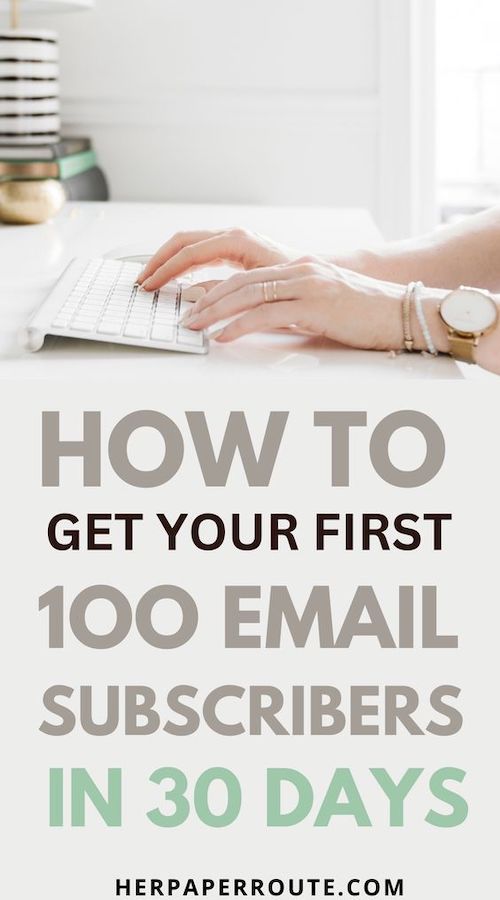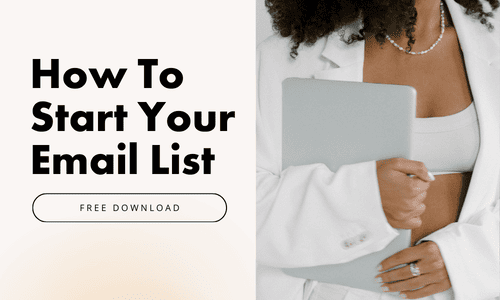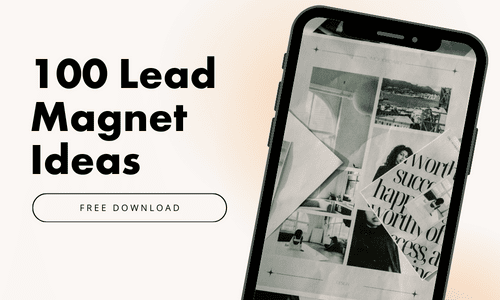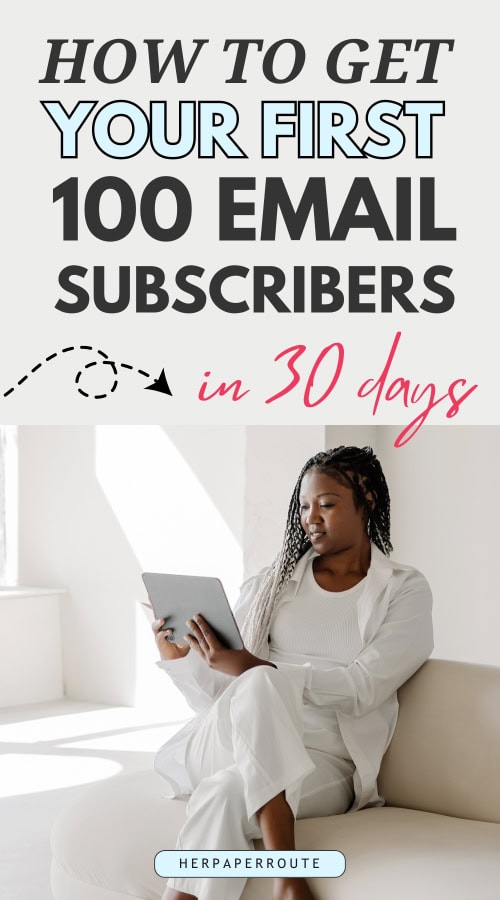7 Strategies To Get Your First 100 Email Subscribers In 30 Days

I have a few fool-proof strategies for how you can get your first 100 email subscribers in the next 30 days. Want in?
When you’re brand new to online business and trying to build your list, a lot of what you do will be hit-or-miss.
As an affiliate partner of various brands and sponsored content, HerPaperRoute may earn commission on qualifying purchases. Disclaimer
It can be super frustrating to feel like you’ve created the perfect opt-in freebie, only to have zero people sign up for it. I’ve been there!
Thankfully, my list-building strategies have gotten a lot better over the last few years. And today I want to share my tips with you.
The 7 strategies I’m sharing below are things that helped me grow my own list to 100 subscribers, 10,000 subscribers, and beyond.

Strategy #1. Offer super actionable Lead magnet Freebies
A lead magnet is a free resource or incentive that is offered to potential customers in exchange for their contact information, such as their email address.
Your freebies and content upgrades should be super useful, actionable, and something that couldn’t have just as easily been made into a blog post.
That last point is important.
If your readers see your freebie and think, “Why didn’t she just write this as a blog post?”, they’re going to feel like you’re holding out on them.
Examples of actionable freebies include things like:
- Workbooks
- Video tutorials
- Schedulers or planners
- Checklists
To make a lead magnet high-value and helpful to the recipient, it should have the following factors:
Relevant: The lead magnet should be relevant to the recipient’s needs, interests, or pain points. It should offer a solution to a problem they are facing or provide information that they are looking for.
Valuable: The lead magnet should provide significant value to the recipient. It should be something that they would be willing to pay for if it were a paid product or service.
Actionable: The lead magnet should provide actionable steps or information that the recipient can use immediately to achieve their desired outcome.
Easy to consume: The lead magnet should be easy to consume, whether it’s a short ebook, a checklist, a video tutorial, or an infographic. The recipient should be able to quickly and easily understand the information provided.
Unique: The lead magnet should be unique and stand out from other similar resources available in the market. It should offer a fresh perspective or unique approach to solving a problem.
Visually appealing: The lead magnet should be visually appealing and well-designed.
This helps to capture the recipient’s attention and makes it more likely that they will engage with the content.
You can design beautiful lead magnets using Canva. As well, Styled Stock Society offers really great lead magnet templates you can customize and give away.
By incorporating these factors into your lead magnet, you can make it high-value and helpful to the recipient, which can help to increase your conversions and grow your email list.
Why this strategy works
Creating actionable freebies shows that you’re willing to go above and beyond to provide value for your readers.
Plus, people are more willing to hand over their email addresses for a workbook.
Muchmore so than for something too simple like a list of five tips that they could probably find elsewhere online without needing to cough up their email address.
Read: Lead Magnet Ideas That Grew My List Like Wild
You will get your first 100 email subscribers in 30 days fast.
Strategy #2. Switch up your freebies
When you’re just starting out, you’ll want to create a mix of different freebies to see what your audience responds to best.
Switch it up between a workbook, a checklist, and maybe a video tutorial to see which gets the most signups.
Why this strategy works
Chances are, certain types of freebies and certain topics will appeal to your audience more than others.
It’s up to you to figure out what those topics and formats are.
Play around with it, and don’t become too attached to one particular idea. Be flexible, and try out different formats and topics until you strike gold.

Strategy #3. Create a resource library
What’s better than a single freebie? LOTS of freebies!
Pile a bunch of free resources together into one big library and then make the library a password-protected page on your website.
And then in order to get the password, people have to sign up for your email list.
To create a password-protected resource library page in WordPress, you can follow these steps:
- Create a new page in WordPress for your resource library. To do this, go to Pages > Add New in the WordPress dashboard.
- Once you have created the page, you need to add your resources to it. You can do this by linking to where you have the files hosted (Google Drive, Dropbox, etc)
- Next, you need to add password protection to the page. To do this, go to the Publish box on the right-hand side of the page editor, and click on the Edit link next to Visibility. Select the option for Password protected, and then enter a password that users will need to enter in order to access the page.
- Click on the OK button to save your changes.
With these steps, you should now have a password-protected resource library page in WordPress where users can access your resources by entering a password.
Why this strategy works
Everyone loves free stuff! And the more free stuff, the better.
Strategy #4. Create a free email course
Creating a free email course can be a great way to attract new subscribers to your email list and provide them with valuable content.
One of my email courses alone has added more than 600 people to my email list in the last 30 days.
Crazy, right?
Although email courses take more work to put together than a standard opt-in freebie does, the results can be so worth it.
Here’s how you can create a free email course:
Choose a topic: The first step in creating a free email course is to choose a topic that your audience will find valuable.
Think about what your audience is struggling with or what they want to learn more about.
Read: Tips for Choosing a great course topic
Plan your content: Once you have chosen a topic, plan out the content for your email course.
Break down the topic into a series of lessons or modules, and determine what you will cover in each email.
Choose an email marketing platform: You’ll need to choose an email marketing platform to create and send your emails.
There are many options available, including Flodesk, and ConvertKit.
Create a landing page: Create a landing page for your email course where people can sign up to receive the emails.
The landing page should provide a brief description of the course and the benefits of signing up.
Read: How to build high-converting landing pages
Write your emails: Write the content for each email in your course. Keep each email focused on one topic and provide actionable tips and advice.
Set up your email automation: Once you have written your emails, set up the email automation in your email marketing platform.
This will ensure that your subscribers receive each email in the course at the appropriate time.
Promote your email course: Promote your email course on social media, your website, and other marketing channels to attract new subscribers
Read: Clever ways to promote your offers
Why this strategy works
The information and value you can provide in an email course is unparalleled, and it makes for a pretty tempting opt-in.
Plus, email courses help your subscribers get comfortable seeing your name in their inbox which is important.
Especially when you start sending weekly newsletters or implementing sales funnels down the road.

Strategy #5. Send out a weekly newsletter
Entice your readers into signing up for your email list by letting them know that you send bonus content to your subscribers every single week.
Bonus content is simply any kind of content that you haven’t already shared on your blog, your website, or social media.
And yes, that means you can’t just re-hash your latest blog post in an email.
A simple blog post summary isn’t going to make me want to join or stay on your list.
Why this strategy works
This strategy works because it’s fun to feel like you’re part of a secret club and that you’re getting special, secret information that only a select group of people are getting.
Personally, I love being on the mailing lists of my favorite entrepreneurs and being the first to know when they’ve published new content.
I also like when they send out personal emails and behind-the-scenes sneak peeks into their lives.
I give special bonuses, secret deals and members-only workshops to my subscribers, and they LOVE it. Get into my newsletter here.
Strategy #6. Have 2-3 opt-in opportunities on every page of your website
Try to put email list signups in at least 2-3 different spots on every page of your website.
For example, you can promote your freebies in:
- The top bar on your website
- The top navigation menu
- On a cover page or welcome mat
- In the sidebar
- In the footer
- In your blog posts
Variety is key here, and you should use each of these places to promote a different kind of opt-in freebie.
For example, in your sidebar, you might have a signup for your weekly newsletters and an opt-in for a checklist.
You could then use your top bar to promote your email course and promote various other content upgrades throughout your blog posts.
Why this strategy works
What appeals to one person might not appeal to somebody else.
Having a variety of options on every page ensures you aren’t missing out on potential subscribers by promoting only one type of freebie or sharing it in only one spot.
Strategy #7. Share your opt-ins on social media
Share your freebies on your Facebook page, in Facebook groups, on Twitter, Instagram, and Pinterest.
Go wild with it!
Why this strategy works
Your followers won’t read every single piece of content you create and they definitely won’t see every single tweet or Facebook update you post.
They miss things. It’s your job to keep readers informed of all the awesome content you’ve created for them.
Plus, you’ve spent all this time creating the perfect opt-in freebie, so you need to make sure you take the time to promote it properly.
By regularly mentioning your freebies on social media, you’re helping out your readers who missed hearing about those freebies the first time around.
7 Strategies To Get Your First 100 Email Subscribers In 30 Days – Conclusion
7 of my top strategies for growing your email list and getting your first 100 subscribers.
Which of these strategies have you used to grow your email list?
Which strategies will you be trying out next? What else has worked for you when it comes to growing your list?

Follow along on Instagram!










